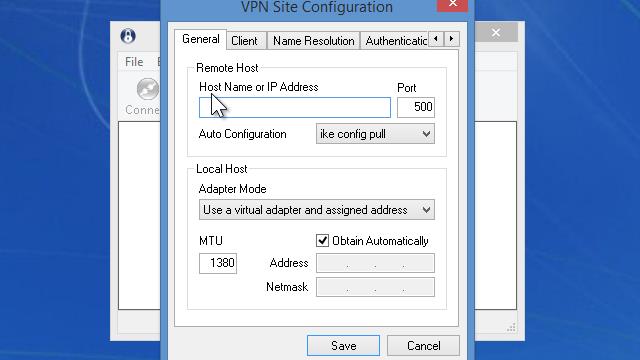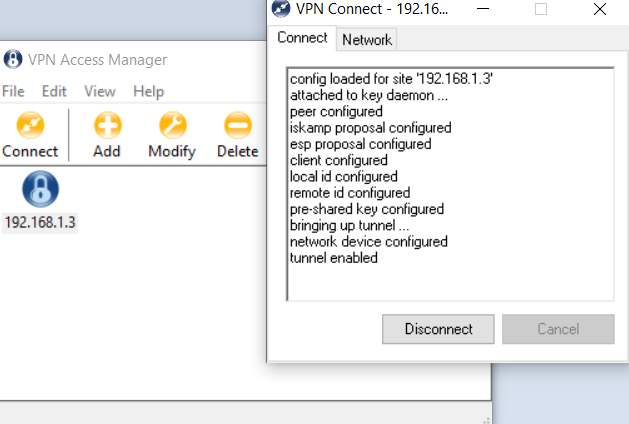
- #Shrew software vpn how to use license key
- #Shrew software vpn how to use install
- #Shrew software vpn how to use update
- #Shrew software vpn how to use windows
IPsec, or Internet Protocol Security, enables you to encrypt and transfer data between two security gates or between a gateway and a host.
#Shrew software vpn how to use windows
Shrew Soft VPN Client is a simple to use IPsec remote access VPN client that is especially created to offer a safe means of communication between windows hosts and open source VPN.
#Shrew software vpn how to use install
The trial period will now only start when the user chooses install the Professional version. Fix a problem that caused the Professional edition 14 day trial to start even when the Standard edition was installed.The client will now only attempt to reconnect after the initial connection succeeds. Previously when this feature was enabled, the client would attempt to reconnect even if user authentication failed. Modify the VPN Connect program to correct poor behavior related to the auto reconnect feature.
#Shrew software vpn how to use license key
This should allow users to evaluate the VPN Client professional edition features as new releases are made available but still require a license key for long term use. This will occur once when a newer pre-release version is installed and once again when a newer release version is installed. When a newer version of the VPN Client is installed, the trial period is now reset.
#Shrew software vpn how to use update


(6) Choose the menu Phase 2, under the Proposal Parameters, the Transform Algorithm, HMAC Algorithm are the same with VPN Router’s, we use esp-3des, md5 here. (5) Choose the menu Phase 1, under the Proposal Parameters, the Exchange Type, DH Exchange, Cipher Algorithm, and Hash Algorithm are the same with VPN Router’s, we use aggressive, group 2, 3des, md5 here. (4) Choose the menu Authentication > Credentials. Specify 321 as FQDN String in Local Identify section and specify 123 as FQDN String in Remote Identify section. Select Fully Qualified Domain Name as Identification Type. Select Mutual PSK as Authentication Method.

(2) Choose the menu Name Resolution, don’t tick the Enable DNS and the Enable WINS. Select Use an existing adapter and current address as Adapter Mode. Specify Host Name or IP Address as 10.10.10.10. Once the VPN server or client is behind a NAT device, the proposal cannot be specified as ah-md5 or as –sha1, otherwise, the VPN tunnel can’t be established. Specify Encapsulation Mode as Tunnel Mode.(3) In the Phase-2 Settings section, configure the IKE phase-2 parameters. Here we specify the local ID as 123 and remote ID as 321. Specify the local/remote ID as you like.Once the VPN server or client is behind a NAT device, we have to select Aggressive Mode as Exchange Mode and select NAME as Local/Remote ID Type, otherwise, the VPN tunnel can’t be established. Specify Negotiation Mode as Responder Mode.Specify Exchange Mode as Aggressive Mode.In the Phase-1 Settings section, configure the IKE phase-1 parameters. (2) Click Advanced Settings to load the following page. Specify the Pre-shared Key as you like.Specify WAN as WAN1 and local subnet as 192.168.0.0/24.You also can enter 0.0.0.0 to allow any IP address. Specify the Remote Host as 10.10.10.20.Configure the basic parameters for the IPsec policy. (1) Choose the menu VPN > IPSec > IPSec Policy and click Add to load the following page on the VPN router.

Step1 Verify the settings needed for IPsec VPN on routerĬhoose the menu Status > System Status and Network > LAN. Take the following topology as an example, we will learn how to configure the VPN server and VPN client. But we need to use some VPN client software like Shrew. Then we can access the private network of the VPN Router securely via the internet. With Client to LAN VPN function, the VPN Router will be a VPN server and we can use our PCs to establish the VPN tunnel with it.


 0 kommentar(er)
0 kommentar(er)
